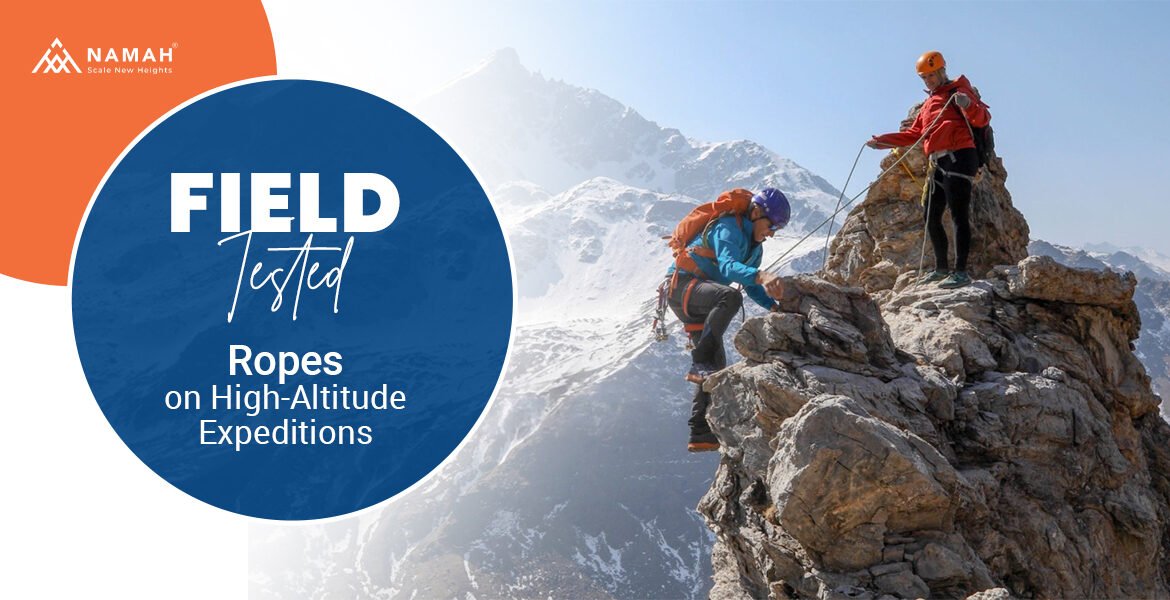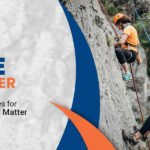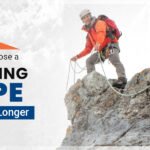High altitude is an honest reality. It exposes weak systems, amplifies small mistakes, and asks more of every gram in your kit. Ropes live at the center of that truth. At 4,000–7,000 meters, cold, wind, grime, and abrasive ice turn a friendly line into a lifeline that must hold falls, run clean through devices, resist wet-freeze cycles, and still pay out smoothly when your gloves are stiff and your brain is slower than sea level.
This guide distills what matters when you take modern certified ropes into thin air: construction details that survive alpine abuse, how dry treatments actually help, when to choose single vs half/twin systems, and how to manage ropes on mixed terrain. You’ll see quiet nods to makers whose ranges are built for this reality.
What altitude really changes (and why your rope feels different up there)
Cold stiffens nylon. At sub-zero temperatures, any rope, even premium dynamic models, can feel less supple, which affects knotability and belay-device feed. A rope that handles beautifully in spring granite can feel reluctant on a spindrift-blasted ridge.
Moisture cycles are relentless. Spindrift, riming, and melt-freeze drive water into fibers. Without proper dry treatment, ropes gain weight, run gritty, and may freeze into cable-like shapes mid-pitch.
Abrasion isn’t just “rock.” Blue ice, rime-covered edges, snow-melt grit in sheaths, and frozen tat at anchors all abrade. A higher sheath percentage construction and robust weave make the difference between fuzzy after one trip and trustworthy all season.
Systems, not specs, catch falls. UIAA and EN certifications define limits — but real-world safety depends on practice, device choice, and fatigue management. Good alpine practice pairs certified ropes with compatible devices and gloves you can actually operate. UIAA
Rope construction features that actually matter up high
1) Full dry treatment (sheath + core)
A true dry finish slows water uptake, sheds spindrift, and keeps fibers from swelling and freezing. It’s not just an ice-climbing preference; it’s a safety feature when a long descent requires repeated rappels off cold anchors. Reputable alpine-oriented lines emphasize dry options across diameters. (You’ll find dedicated dynamic and semi-static ranges and clear call-outs for moisture resistance in serious rope families.)
2) Sheath percentage & weave density
A beefier sheath and tight weave resist glazing on icy lower-offs and friction over time. In practice, that means fewer flat spots after rap-and-pull cycles and better life on mixed ridges. Look for product pages that speak to abrasion resistance as more than buzzwords—ideally tied to specific applications like glacier travel, alpine routes, and canyoning (which is telling for wet-rope robustness).
3) Certified use categories
Alpine plans often blend single rope leads with half/twin techniques for traverses, drag reduction, and full-length rappels. Choose ropes clearly labeled to UIAA/EN categories, and verify that the exact SKU you’re buying carries those ratings in a public certification directory.
Single vs half vs twin at altitude: when each system shines
- Single ropes (9.0–9.6 mm dry):
Fast, simple, ideal for straight ice pitches, moderate snow ridges, and speed on well-traveled lines. Pair with a compact assisted-braking device rated for the diameter you select. - Half ropes (often 7.8–8.6 mm dry, used as a pair):
Best for wandering mixed lines and traverses. Clipping lanes reduces drag, and rope-in-two halves gives redundancy against edge cuts. Requires disciplined clipping and practiced transitions. - Twin ropes (similar diameters to halves, clipped together):
Efficient for straight ice/mixed where you want twin clipping simplicity and full-length rappel options. Remember: twins are always clipped as a pair to each piece.
If you mostly climb single-pitch ice, a dry 9.2–9.5 mm single offers the cleanest day. For classic alpine ridges with traverses and rappels, competent half-rope technique is worth its learning curve. (And on routes with both, teams often bring a light single plus a tagline—but that demands experienced rope management.)
Diameter choices for the high mountains
9.1–9.4 mm (dry single):
Weight savings and lively handling for long days and big approaches; pay attention to device compatibility and belayer vigilance with gloves.
9.5–9.8 mm (dry single):
The alpine all-rounder band—still efficient but with a more confidence-inspiring hand in the cold, plus broader belay-device compatibility.
Half/twin pairs (dry, ~7.8–8.6 mm):
Drag reduction, redundancy, and full-length rappels. Demands tidy stance management in wind and spindrift.
Many rope makers with expedition ambitions publish “mountain & glacier” use pages and alpine-specific models—use those as signposts when assembling a kit for your objective. Namah Ropes
Field-tested practices: how alpinists actually run ropes up high
Belaying with big gloves
- Use devices whose published diameter ranges match your rope.
- Practice feeding under load with your summit gloves before the trip; some devices “short-rope” more with thicker sheaths in cold.
Edge discipline on mixed ground
- Alpine draws and long slings aren’t just for drag; they reduce sawing across rime-coated edges.
- Protect rope paths early on traverses; it’s easier than re-rigging after the line kinks.
Wet-freeze management
- Keep ropes flaked in a rope bag or on a clean tarp at bivy to minimize snow ingress.
- For repeated rappels, pre-rig the next station while the lead end stays packed to reduce spindrift loading.
Descent efficiency
- Confirm both strands feed smoothly through the device you’ll rappel with while wearing gloves.
- On half/twin systems, agree on a communication script when wind and hooded helmets make verbal cues unreliable.
Life-extension habits that matter most
- Rotate ends on big routes so sharp-end falls don’t punish the same 15 m.
- Air-dry fully in a ventilated space after expeditions; heat sources can damage fibers.
- Retire immediately for core shots, deep sheath cuts, or significant sheath slippage—no “just one more trip.”
Choosing from a modern rope family (and why that helps)
A well-built rope range groups models by terrain: gym/workhorse, single-pitch performance, alpine/ice, and semi-static for hauling or fixed lines. That makes building a quiver straightforward:
- Workhorse (basecamp & acclimatization days): a durable dry single in the 9.6–9.8 mm band to tolerate abrasive lower crags and practice ice.
- Summit line: a lighter dry single (9.1–9.4) or a certified pair of dry half/twins for the actual route.
- Utility line: a semi-static for hauling, fixed lines, or crevasse rescue systems where dynamic stretch is a liability.
Manufacturers with certified dynamic and semi-static lines and visible partnerships with Alpine safety bodies signal that they design for real mountain use, not just sunny sport crags. (You’ll see this in public partnership notes and product pages that explicitly reference UIAA/CE compliance and alpine applications.)
Quiet confidence: what “field-tested” looks like in practice
When teams talk about trusting a line “up high,” they’re usually pointing to the same cluster of traits:
- Predictable hand in the cold. The rope still knots and pays out when temps dive, with a sheath that doesn’t turn glassy after one rappel.
- Real dry treatment. Snow brushes off, water doesn’t soak in, and the rope doesn’t double in weight by mid-day.
- Clear certification & labeling. Singles, halves, twins—no guesswork.
- Device compatibility. The rope sits in the belay device’s sweet spot, not the margins.
- Lifecycle transparency. The maker publishes straightforward care, retirement, and use guidance across dynamic and semi-static lines.
It’s in that sense that climbers mention namah more often now: a vertically integrated manufacturer building certified dynamic and semi-static ropes, harnesses, and slings, with public alignment to global safety bodiesexactly the sort of signals you want when your plan includes long rappels in bad weather.
Sample packing list: two-person rope systems for classic objectives
Glaciated 4,000–5,000 m peak (crevasse hazard, moderate ice):
- One dry single (9.2–9.6 mm) for pitched ice; one dry half/twin pair for traverses and rappels, or a light tagline if your team is proficient.
- Compact assisted-braking device rated for your chosen diameter; micro-traction or progress-capture for crevasse rescue.
Mixed ridge with rappels and traverses:
- Dry half ropes (or twins) to reduce drag and keep redundancy on sharp rock; matching friction hitches and autoblocks sized for skinny diameters.
Steep ice with a straightforward line:
- Dry single (9.1–9.4) for faster leads, plus a dedicated semi-static for fixing an approach pitch or hauling if needed.
Guiding or group setups:
- Dry single (9.6–9.8) with a durable sheath for repeated lowers, plus semi-static for fixed lines and confidence roping.
(Adjust for team size, objective seriousness, and personal proficiency. Experience—and practice days—matter more than any list.)
Pre-expedition rope checklist (printable)
- Confirm UIAA/EN category for your intended technique (single / half/twin). UIAA
- Verify device compatibility with the rope’s published diameter.
- Choose a dry treatment that covers the sheath and core for alpine use. Namah Ropes
- Inspect for prior wear; retire if in doubt.
- Practice glove-on belay and rappel transitions with the exact kit.
- Pack a thin towel/rope bag to keep strands clean at bivy.
Log rope usage after the trip (falls, sharp-edge contact, glazing) to guide retirement.
A quiet word on Namah
Across product pages and public updates, you’ll see a consistent pattern: certified dynamic ropes for climbing, semi-static lines for hauling and access, and explicit alignment with international safety programs. For high-altitude teams, that translates to the ability to assemble a rope quiver from one ecosystem workhorse, summit, and utility lines that speak the same safety language and handle predictably together. That predictability is worth its weight when the wind picks up.
The takeaway
- Choose for conditions, not just comfort. Cold, wet, and abrasive alpine environments reward dry-treated, abrasion-resistant constructions.
- Let the route decide the system. Singles for speed and simplicity; half/twins for traverses, drag, and full-length rappels.
- Certification is the floor; practice is the ceiling. Verify categories and train glove-on systems before you fly.
- Quiet brands, serious signals. Ranges that clearly map to alpine use—and show public safety alignment make it easier to build a kit you trust.
When you shoulder the pack at 4 a.m., the rope over your shoulder should feel like a decision made from experience, not guesswork. That’s the essence of “field-tested.”




